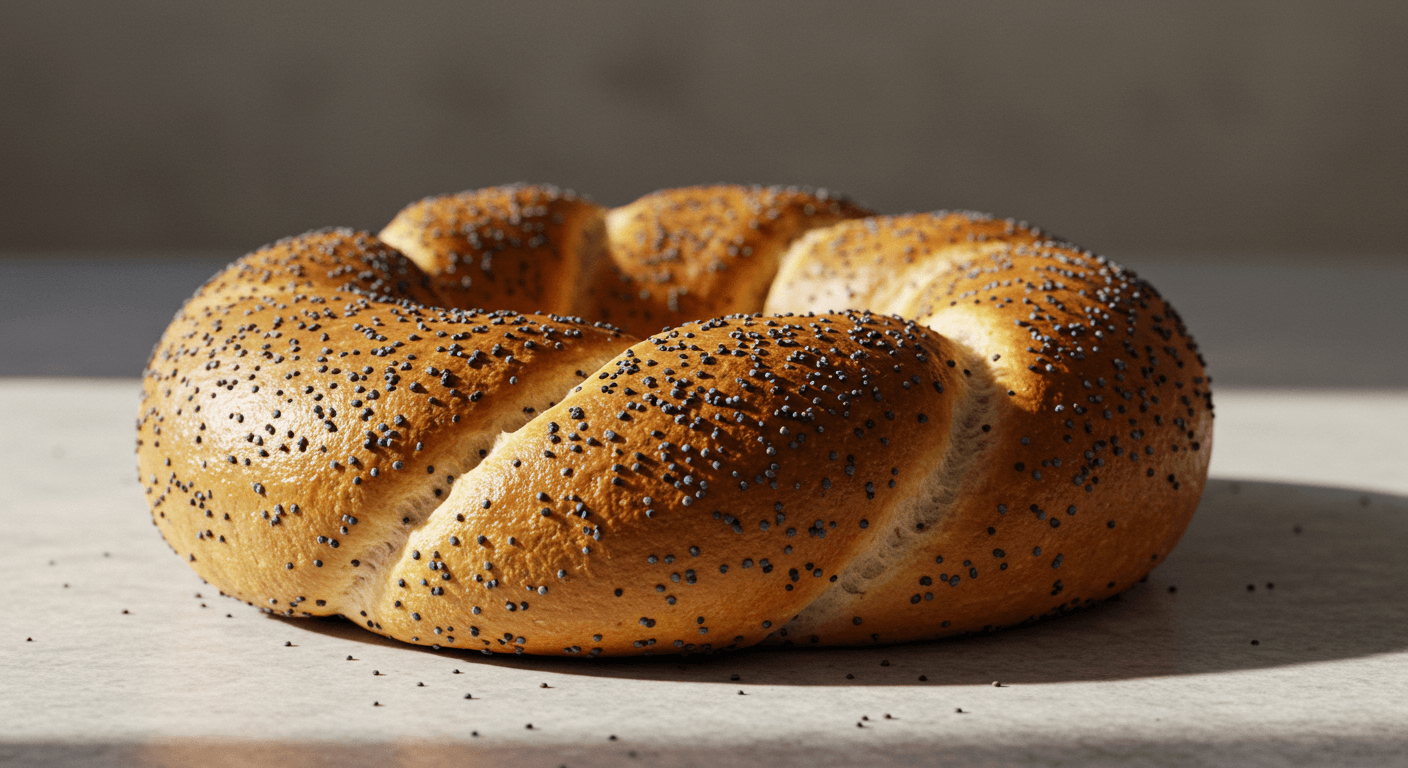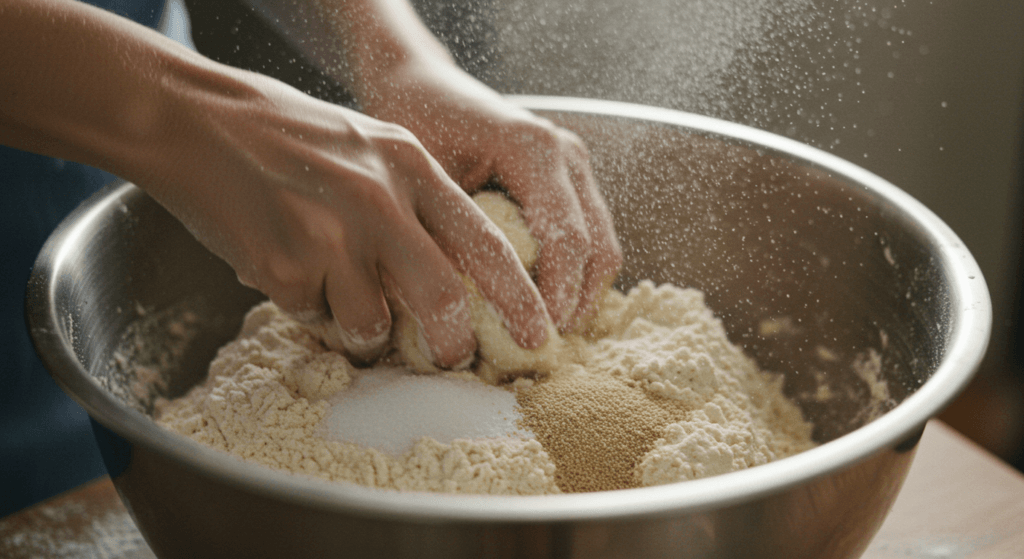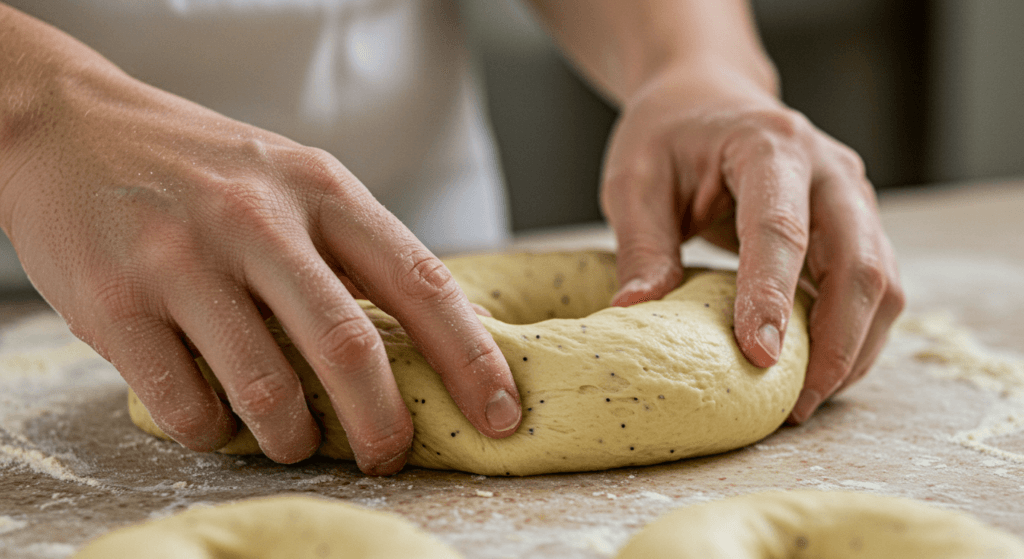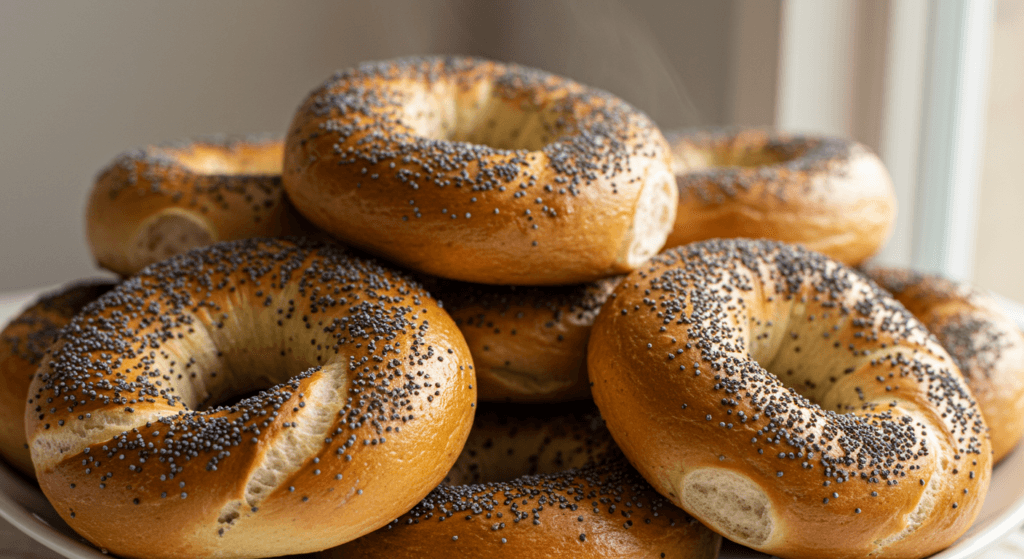Introduction
Are you ready to embark on a delightful culinary journey? 🌟 Welcome to the ultimate guide to making perfect poppy seed bagels at home. Bagels, with their chewy texture and delightful toppings, are a favorite breakfast treat for many. And when it comes to poppy seed bagels, the tiny black seeds add a nutty flavor that makes them absolutely irresistible.
In this guide, we’ll take you through everything you need to know about poppy seed bagels—from their history and ingredients to step-by-step instructions and troubleshooting tips. Whether you’re a seasoned baker or a kitchen newbie, you’ll find this guide both informative and fun. So, let’s get started!

“Cooking is like love. It should be entered into with abandon or not at all.” — Harriet Van Horne
What Are Poppy Seed Bagels?
Poppy seed bagels are a type of bagel topped with poppy seeds before baking, giving them a distinctive nutty flavor and crunchy texture. Bagels, in general, are ring-shaped bread that is boiled before baking, resulting in a dense and chewy texture.
History of Poppy Seed Bagels
Bagels have a rich history that dates back to 17th-century Poland. They were originally given as gifts to women in childbirth. The tradition of topping bagels with seeds, including poppy seeds, likely stems from the Eastern European Jewish communities where bagels were a staple food. Over time, these delicious treats made their way to North America, where they became a beloved part of breakfast culture.
For more insight into bagel varieties, explore this Cinnamon Raisin Bagel Recipe that provides a sweet twist to traditional bagels.
Popularity and Cultural Significance
Poppy seed bagels have become a cultural icon, especially in cities with large Jewish populations like New York. They are often enjoyed with a schmear of cream cheese, lox, or other spreads. The nutty flavor of the poppy seeds complements the chewy texture of the bagel perfectly, making it a favorite for many.
If you’re intrigued by complementary breakfast dishes, check out our Mini Pancake Breakfast Guide for delightful serving ideas.
Ingredients Needed for Poppy Seed Bagels
Ingredient Checklist
| Check | Ingredient | Quantity |
|---|---|---|
| Bread flour | 4 cups | |
| Active dry yeast | 2 1/4 teaspoons | |
| Sugar | 2 tablespoons | |
| Salt | 1 tablespoon | |
| Water | 1 1/2 cups, warm | |
| Poppy seeds | 1/4 cup |
Essential Ingredients
- Bread Flour: Bread flour has a higher protein content than all-purpose flour, which gives bagels their chewy texture.
- Active Dry Yeast: This is what makes the dough rise.
- Sugar: A small amount of sugar feeds the yeast and helps with browning.
- Salt: Essential for flavor.
- Water: Warm water helps activate the yeast.
- Poppy Seeds: For that signature crunch and nutty flavor.
Enhance your baking repertoire by exploring Why Restaurant Pancakes Are So Fluffy to pair your bagels with pancakes for a complete breakfast.
Optional Ingredients
- Honey or Barley Malt Syrup: Adds a touch of sweetness to the boiling water, giving the bagels a beautiful color and flavor.
- Egg Wash: For a shiny, golden-brown crust.
Common Ingredient Substitutions
- Whole Wheat Flour: Can be used in place of some of the bread flour for a different texture and flavor.
- Instant Yeast: Can be used instead of active dry yeast, with some adjustments to the method.
Tools and Equipment Required
Kitchen Tools
- Mixing Bowls: For combining ingredients.
- Measuring Cups and Spoons: Accuracy is key in baking.
- Mixing Spoon or Dough Hook: For kneading the dough.
- Kitchen Scale: Optional but useful for precise measurements.
Baking Equipment
- Baking Sheet: For baking the bagels.
- Parchment Paper: To prevent sticking.
- Pot for Boiling Water: Essential for the boiling step.
- Slotted Spoon: For transferring bagels from boiling water to baking sheet.
Step-by-Step Recipe for Poppy Seed Bagels
Making poppy seed bagels from scratch is a rewarding experience. Follow these steps, and you’ll be enjoying fresh, homemade bagels in no time. 🥯✨

Preparing the Dough
- Mix the Ingredients: In a large mixing bowl, combine 4 cups of bread flour, 2 1/4 teaspoons of active dry yeast, 2 tablespoons of sugar, and 1 tablespoon of salt. Mix well.
- Add Warm Water: Gradually add 1 1/2 cups of warm water (about 110°F/45°C) to the dry ingredients. Stir until a shaggy dough forms.
- Knead the Dough: Turn the dough onto a floured surface and knead for about 10 minutes until it becomes smooth and elastic. If you have a stand mixer with a dough hook, you can use it to knead the dough for about 6-8 minutes.
- First Rise: Place the dough in a lightly oiled bowl, cover it with a damp cloth, and let it rise in a warm place for about 1 hour, or until it doubles in size.
Shaping the Bagels
- Divide the Dough: Punch down the risen dough and divide it into 8 equal pieces.
- Shape Each Piece: Roll each piece into a ball. To shape the bagels, poke a hole through the center of each ball with your thumb, then gently stretch and shape the dough to form a ring with an even thickness.
- Second Rise: Place the shaped bagels on a parchment-lined baking sheet. Cover them with a damp cloth and let them rest for 10-15 minutes.

Boiling the Bagels
- Prepare the Water Bath: Bring a large pot of water to a boil. Add 1 tablespoon of sugar or honey to the boiling water to help the bagels develop a nice color and flavor.
- Boil the Bagels: Carefully place a few bagels at a time into the boiling water. Boil for 1 minute on each side. Remove the bagels with a slotted spoon and place them back on the parchment-lined baking sheet.
Baking to Perfection
- Preheat the Oven: While the bagels are boiling, preheat your oven to 425°F (220°C).
- Add the toppings: Brush the boiled bagels with an egg wash (1 egg beaten with 1 tablespoon of water) for a shiny crust. Sprinkle generously with poppy seeds.
- Bake the Bagels: Bake the bagels for 20-25 minutes, or until they are golden brown. Rotate the baking sheet halfway through to ensure even baking.
- Cool: Transfer the baked bagels to a wire rack to cool completely.
“Good bread is the most fundamentally satisfying of all foods, and good bread with fresh butter is the greatest of feasts.” — James Beard
Tips and Tricks for Best Results
Achieving the Perfect Dough Consistency
- Hydration: If the dough feels too dry, add a little more water, one tablespoon at a time. If it’s too sticky, add a bit more flour.
- Kneading: Proper kneading develops gluten, which gives the bagels their chewy texture. Knead until the dough is smooth and elastic.

Enhancing Flavor and Texture
- Use Bread Flour: The higher protein content in bread flour gives bagels their unique texture.
- Add Malt Syrup: Adding a tablespoon of malt syrup or honey to the boiling water enhances the bagels’ flavor and color.
Troubleshooting Common Problems
- Dense Bagels: If your bagels turn out too dense, it could be due to under-kneading or not letting the dough rise long enough.
- Flat Bagels: This can happen if the dough overrises or if the bagels are boiled for too long.
- Burnt Tops: Keep an eye on the bagels while baking. If they start to brown too quickly, you can tend them with aluminum foil to prevent burning.
Variations and Enhancements
Bagels are wonderfully versatile, and there are many ways to tweak and enhance your poppy seed bagels to suit your taste. Here are a few ideas to get you started:
Adding Different Seeds and Toppings
- Sesame Seeds: Mix sesame seeds with poppy seeds for a delightful crunch and a nutty flavor.
- Everything Bagel Topping: Combine poppy seeds, sesame seeds, dried onion, dried garlic, and coarse salt for a classic everything bagel twist.
- Sunflower or Pumpkin Seeds: These seeds add a hearty and earthy flavor to your bagels.
Making Sweet and Savory Bagels
- Sweet Variations: Add a touch of sweetness by incorporating dried fruits like raisins or cranberries into the dough. You can also add cinnamon and sugar for a sweet breakfast treat.
- Savory Options: Experiment with adding herbs and spices like rosemary, garlic, or onion powder to the dough. You can also sprinkle grated cheese on top before baking for a cheesy bagel.
Storing and Freezing Poppy Seed Bagels
To ensure your bagels stay fresh and delicious, follow these storage tips:
Proper Storage Techniques
- At Room Temperature: Store fresh bagels in an airtight container or plastic bag at room temperature for up to 2 days. To keep them from getting too soft, place a piece of parchment paper between each bagel.
- In the Refrigerator: If you need to store them for a longer period, place the bagels in the refrigerator for up to 1 week. Keep in mind that refrigeration can sometimes make bagels a bit chewy.
Tips for Freezing and Thawing
- Freezing Bagels: For longer storage, freeze your bagels. Slice them in half before freezing to make it easier to toast them later. Wrap each bagel in plastic wrap and place them in a resealable plastic bag or airtight container.
- Thawing Bagels: When you’re ready to enjoy a frozen bagel, remove it from the freezer and let it thaw at room temperature for about 30 minutes. You can also pop it directly into the toaster from frozen.
Serving Suggestions
Bagels are incredibly versatile and can be enjoyed in many ways. Here are some serving suggestions to inspire you:
Delicious Bagel Sandwich Ideas
- Classic Lox and Cream Cheese: Spread cream cheese on your bagel and top with smoked salmon, capers, thinly sliced red onion, and a squeeze of lemon.
- Egg and Cheese Bagel: For a hearty breakfast, fill your bagel with scrambled eggs, cheese, and your choice of bacon, sausage, or ham.
- Veggie Delight: Spread hummus on your bagel and top with fresh veggies like cucumber, tomato, avocado, and sprouts.
Pairing with Cream Cheese and Spreads
- Classic Cream Cheese: You can’t go wrong with a generous schmear of plain cream cheese.
- Flavored Cream Cheese: Try flavored varieties like chive and onion, strawberry, or jalapeño for a unique twist.
- Butter and Jam: For a simple yet delicious option, spread your bagel with butter and your favorite jam or jelly.
Pair bagels with fresh spreads or create sandwiches. Consider pairing them with dishes from our Healthy Yogurt Guide for a nutritious twist.
“The best things in life are simple, made with love, and shared with friends.” — Unknown
Frequently Asked Questions
Why Are My Bagels Too Dense?
Dense bagels can be a result of under-kneading the dough or not allowing enough time for the dough to rise. Ensure you knead the dough until it’s smooth and elastic and give it ample time to rise.
How to Prevent Bagels from Sticking?
To prevent bagels from sticking to the parchment paper or baking sheet, make sure to use a generous amount of flour on the work surface and parchment paper. You can also lightly spray the parchment paper with non-stick cooking spray.
Can I Make Gluten-Free Poppy Seed Bagels?
Yes, you can make gluten-free bagels by using a gluten-free flour blend designed for baking. Follow the same steps, but be sure to adjust the water as needed since gluten-free flour can absorb moisture differently.
Conclusion
Making poppy seed bagels at home is a rewarding experience that allows you to enjoy fresh, delicious bagels any time you like. With the right ingredients, tools, and techniques, you can achieve bagels that are just as good, if not better, than those from your favorite bakery.
Remember to experiment with different toppings and variations to find your perfect bagel. And don’t forget to share your homemade creations with family and friends—they’ll be amazed by your baking skills!
Recap of Key Points
We’ve covered a lot in this guide to making perfect poppy seed bagels at home! Here’s a quick recap of the key points:
- Ingredients: We discussed the essential and optional ingredients needed for making poppy seed bagels.
- Tools and Equipment: From mixing bowls to baking sheets, we highlighted the necessary tools for the job.
- Step-by-Step Recipe: We walked through the process of preparing the dough, shaping the bagels, boiling them, and baking them.
- Tips and Tricks: Shared valuable tips to achieve the perfect dough consistency, enhance flavor, and troubleshoot common issues.
- Variations and Enhancements: Explored different toppings and flavor variations to customize your bagels.
- Storing and Freezing: Provided techniques for keeping your bagels fresh and delicious.
- Serving Suggestions: Offered ideas for delicious bagel sandwiches and pairings with spreads.
Encouragement to Try the Recipe
Making your poppy seed bagels might seem daunting, but trust me, it’s worth the effort! Once you bite into a freshly baked, homemade bagel, you’ll never want to go back to store-bought ones. Remember, practice makes perfect, and baking can be a fun and rewarding experience. So, put on your apron, gather your ingredients, and give this recipe a try. You’ll be a bagel master in no time! 🥯❤️
For more delicious ideas and baking inspiration, check out our Cottage Cheese Flatbread Recipes for versatile flatbread options.
Additional Resources for Aspiring Bakers
If you’re interested in expanding your baking skills beyond bagels, here are some excellent resources to check out:
- Books: “The Bread Baker’s Apprentice” by Peter Reinhart, “Flour Water Salt Yeast” by Ken Forkish.
- Online Courses: King Arthur Baking Company’s baking classes, Skillshare baking courses.
- Websites and Blogs: King Arthur Baking, Serious Eats, The Kitchen.
Happy baking, and enjoy your delicious poppy seed bagels!
“Happiness is homemade, and nothing says love like freshly baked bagels.” — Unknown

